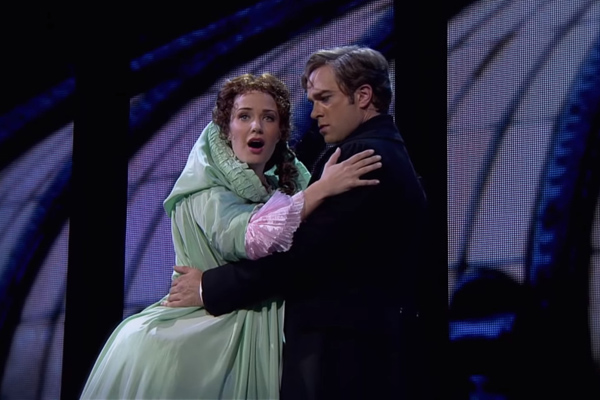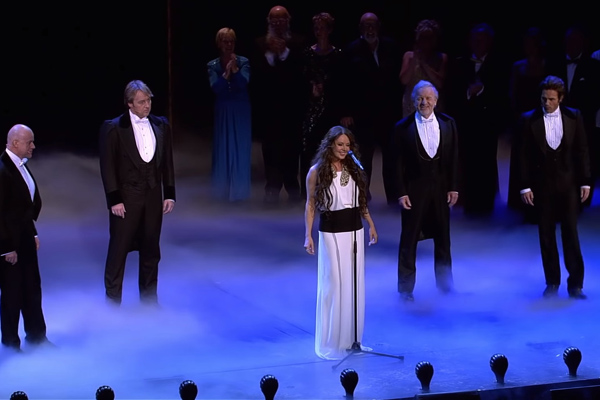Among world musical’s gems is Andrew Lloyd Webber’s The Phantom of the Opera, the musical with lyrics by Charles Hart. It premiered in London’d West End in 1986, and with its captivating story and the abilities that enabled the composer to give us such works as Jesus Christ Superstar, Evita, and Cats, it won seven Tony awards among many others, and became the longest running show in Broadway history, reaching 10,000 Broadway performances in February 2012.
Those and many other factors make this an extremely important show, and make staging it a huge responsibility. For the audience, seeing The Phantom of the Opera is a unique experience, especially when the performance brings together remarkable artists.
And so, on 15 April, the news that Andrew Lloyd Webber would release a complete recorded performance for free online spread like wildfire. The performance which was recorded in 2011 at the Royal Albert Hall was posted on YouTube as a collaboration between the composer’s Really Useful Group and Universal aiming to offer free broadcasts of Lloyd Webber’s musicals.
Offered under the theme of “The Shows Must Go On!” (also name of the YouTube channel), the initiative aims to bring culture to audiences confined to their homes due to the coronavirus pandemic, and posts a number of hours of music every Friday
The Phantom of the Opera aired on 17 April at 7 pm Cairo time, and was available for 48 hours worldwide except for the UK where, due to copyright law, it could only be available for 24. Not surprisingly considering the magnificence of the production, it had had over 12 million views by the time it was taken down. The Royal Albert Hall performance had been part of a celebration marking the show’s 25th anniversary.
Produced by the Cameron Mackintosh and the Really Useful Theatre Company and stage directed by Laurence Connor (Nick Morris directed the video), it features Ramin Karimloo as the Phantom, Sierra Boggess as Christine Daaé and Hadley Fraser as Raoul (Vicomte de Chagny).
The orchestra consisting of over 200 musicians was conducted by Anthony Inglis. Even more exciting was the fact that after the performance Lloyd Webber invited to the stage the musical’s original stars from the London and Broadway productions, including Michael Crawford, the renowned British singer, and Sarah Brightman, the heroine of many of his works and his wife (1984-1990), besides being his Angel of Music, a term he borrowed from Hart’s lyrics to describe her
Glamour aside, however, it is the performance’s strong creative values – including the magnificence of the Royal Albert Hall, where on the occasion Lloyd Webber described how mesmerised he was when he attended the Beethoven’s Symphony No. 3 as a young man – that made it effective even on the screens of the home. A captivating fairy tale based on the 1910 French novel Le Fantôme de l’Opéra by Gaston Leroux, the show is a multifaceted experience.
Set in a mysterious 19th-century Paris theatre (the text specifies the Paris Opera House), it concerns the haunting of a troupe of actors and opera singers by an invisible phantom whose voice instructs them on productions and casting. They know they would pay a high price if they ignored his orders. A talented young soprano, Christine Daaé is the first to meet the stranger and unveil his story.
The Phantom of the Opera is also a unique melodramatic love story in which two men vie for one woman’s love. Many creative maneuvres become possible as a result. The musical doesn’t necessitate the crashing of the chandelier (as in the original story) to maintain its tension. In the video Laurence Connor manages to position the viewer optimally for the drama. In most scenes the audience views the events on stage as if they were in the spectators’ seats at the French theatre in question, occasionally going backstage to eavesdrop on the performers’ chitchat and the machinery of theatre.

Ramin Karimloo and Sierra Boggess in The Phantom of the Opera at the Royal Albert Hall (2011) (Photo: IMDb)
In one, captivating scene, the troupe members give us their backs and bow to the audience on the other side of the stage. Face-à-face with the other audience, we see the full architecture of the theatre. The Royal Albert Hall is used to its full potential with the balconies reserved for the troupe. The costumes and makeup add to the mesmerising aesthetics of the show, from the delicate outfits of the period to the grotesque costumes of the opera singers. Here Carlotta Guidicelli (portrayed by Wendy Ferguson) is the epitome of a diva who finds it hard to step down no matter how unsuited to the role her age has made her: a typical prima donna known to all opera companies… Terrorising the whole troupe, she refuses to give her place to a younger talent, such as the innocent, beautiful and fresh Daaé.
Taken by the marvelous visuals and well drawn characters, we must not forget that at the heart of a musical’s power is the music, the dominant component with the recitative parts are very limited. Magical in its own right, this is one of Lloyd Webber’s most iconic compositions and demands a grand orchestra and concert band bringing the beauty of the score to our ears. In an unusual way the score combines orchestral grandeur with rock and electronic sounds.
The title song has become Webber’s musical signature, one that elevated him throughout his career. We are carried through many melodic lines and surprised with disharmonies perfectly fused into the composition; the composer’s creative range takes us through operatic arias, lyrical ballads, elegant dances and dynamic segments. This is probably one of the secrets behind the musical’s success as it manages to speak to all music lovers, it surprises all tastes and captures them with its colours.
Extremely challenging for the leading voices, the staging of The Phantom of The Opera always reaches out to the best singers. Sarah Brightman with her range, power of delivery and colourful precision was Webber’s first choice for the role of Christine. In fact some sources note that the part was especially written for the English soprano.

Hadley Fraser and Sierra Boggess in The Phantom of the Opera at the Royal Albert Hall (2011) (Photo: IMDb)
A gifted singer in her own right, Sierra Boggess is very different to Brightman. Her Christine emanates an attractive tenderness intertwined with sparkling musicality – no wonder she is best known for singing Ariel in Broadway’s production of The Little Mermaid. Her innocent and somehow helpless, yet charmingly delicate disposition brings the most intricate details of Lloyd Webber’s score softly to light, as she impressively moves to the famed high E that ends the title song.
Throughout the musical we enjoy the beauty of the voices and especially the touching chemistry between the three remarkable leads since Boggess is joined by the Iranian-Canadian singer Ramin Karimloo (the Phantom) with his strong vocal definition, and a British singer, Hadley Fraser (Raoul), whose great skill is coupled with effortless delivery.
Watching the musical from the couch on a home-screen is not the same as the reality and emotions experienced by the spectator in a hall. But though we might miss the feelings of a live atmosphere we can still benefit from numerous components that the in-hall audience does not necessarily experience. Following the choices of the camera, we are able to see the stage from different angles, enjoy close-ups on the performers and experience different – not necessarily less enjoyable – emotions.
On the other hand, in the era of advanced technology, don’t we watch theatrical, orchestral or operatic performances live streamed by some renowned theatres, whether on smaller or bigger screens? Don’t we watch those or other recordings on home screens enjoying them one way or another? The quarantine created many limitations and forced us to stay home more than ever refraining from face-to-face interaction with people. But there are many benefits to the situation we are in, and among them are the cultural institutions releasing the gems which we might not have been able to watch during regular life circumstances.
Watching the recording of The Phantom of the Opera performed at the Royal Albert Hall is definitely one great gain.

Sarah Brightman, Peter Jöback, Anthony Warlow, Colm Wilkinson, and John Owen-Jones in The Phantom of the Opera at the Royal Albert Hall (2011) (Photo: IMDb)
*A version of this article appears in print in the 23 April, 2020 edition of Al-Ahram Weekly
Short link: